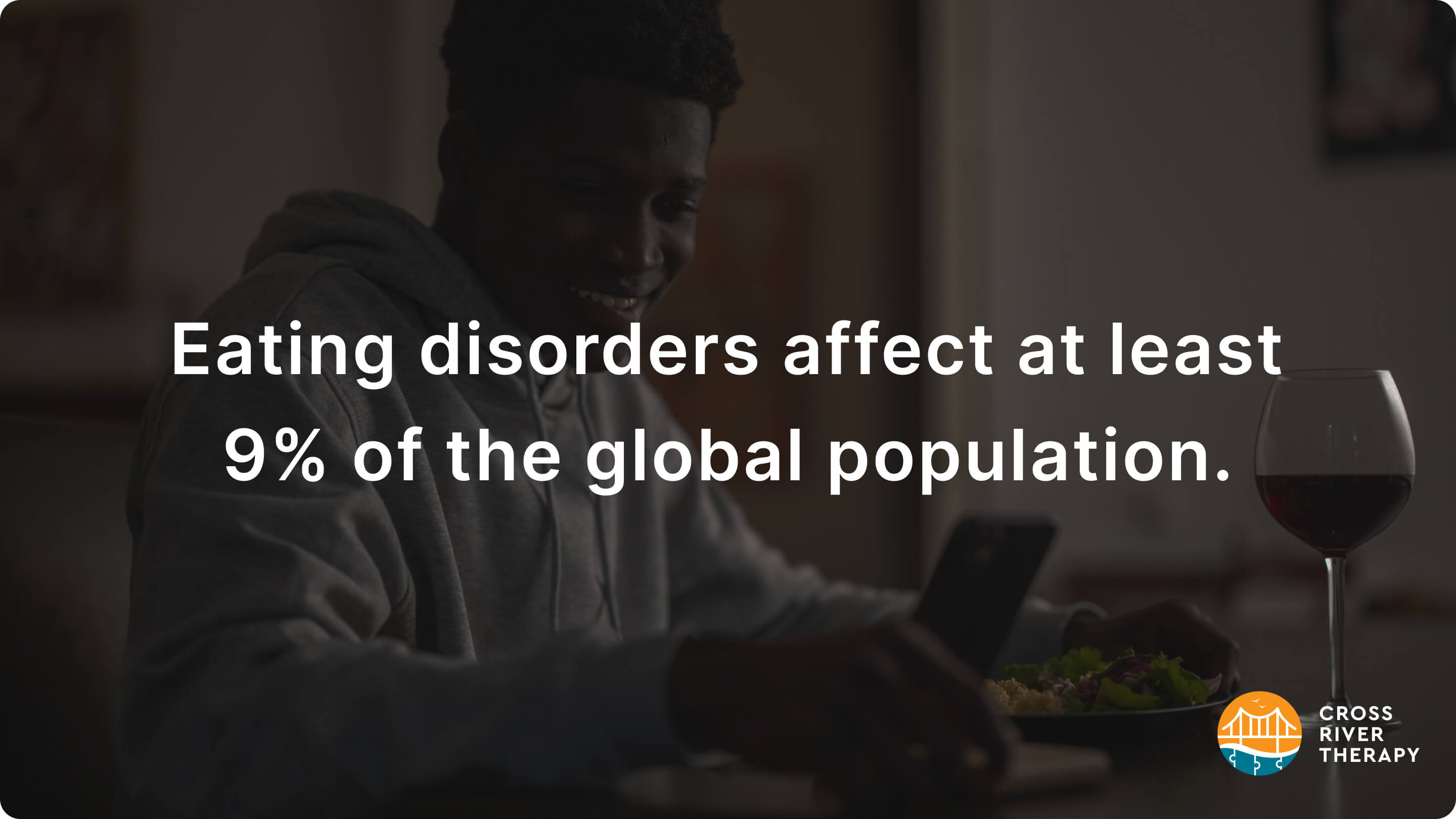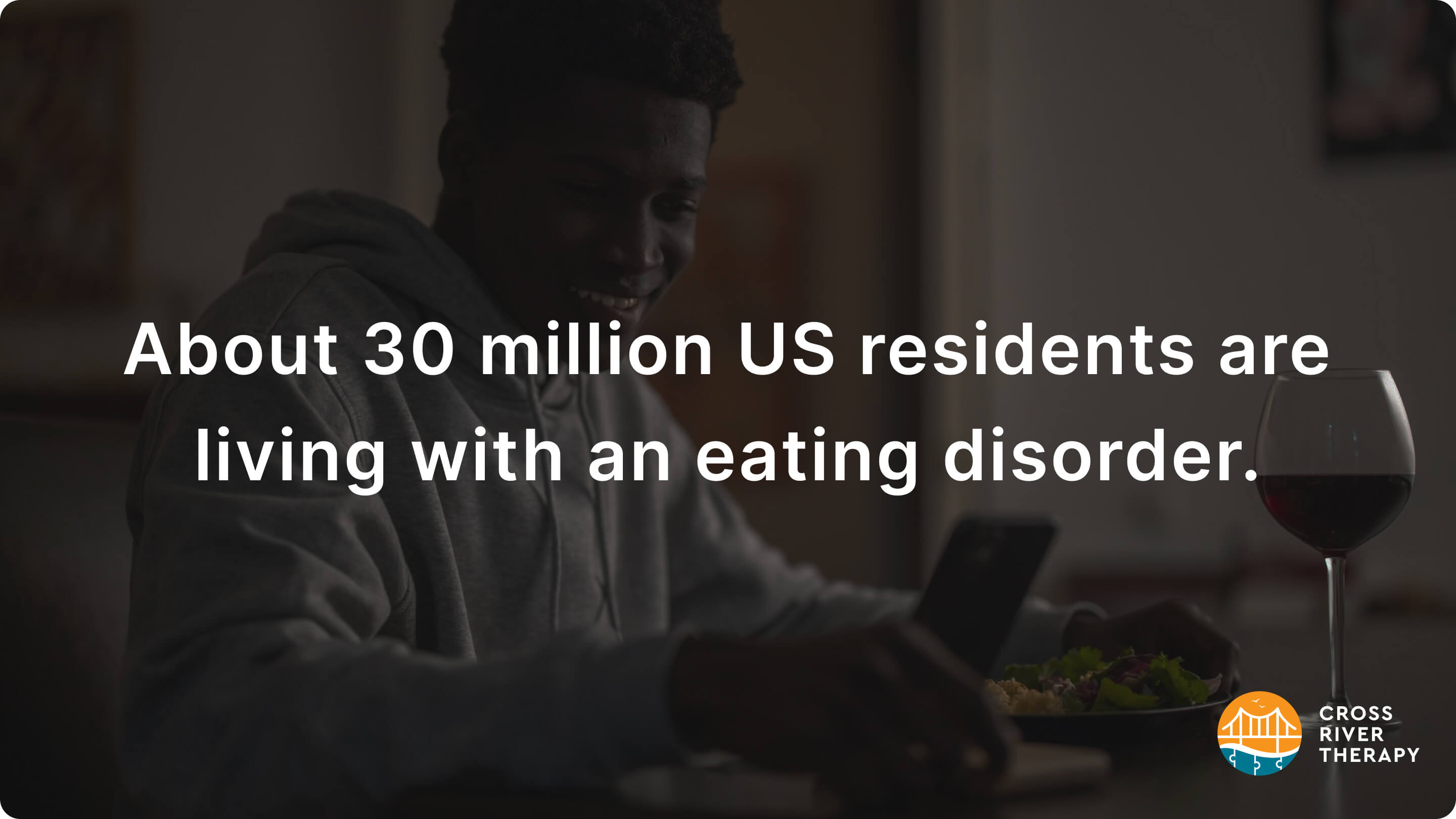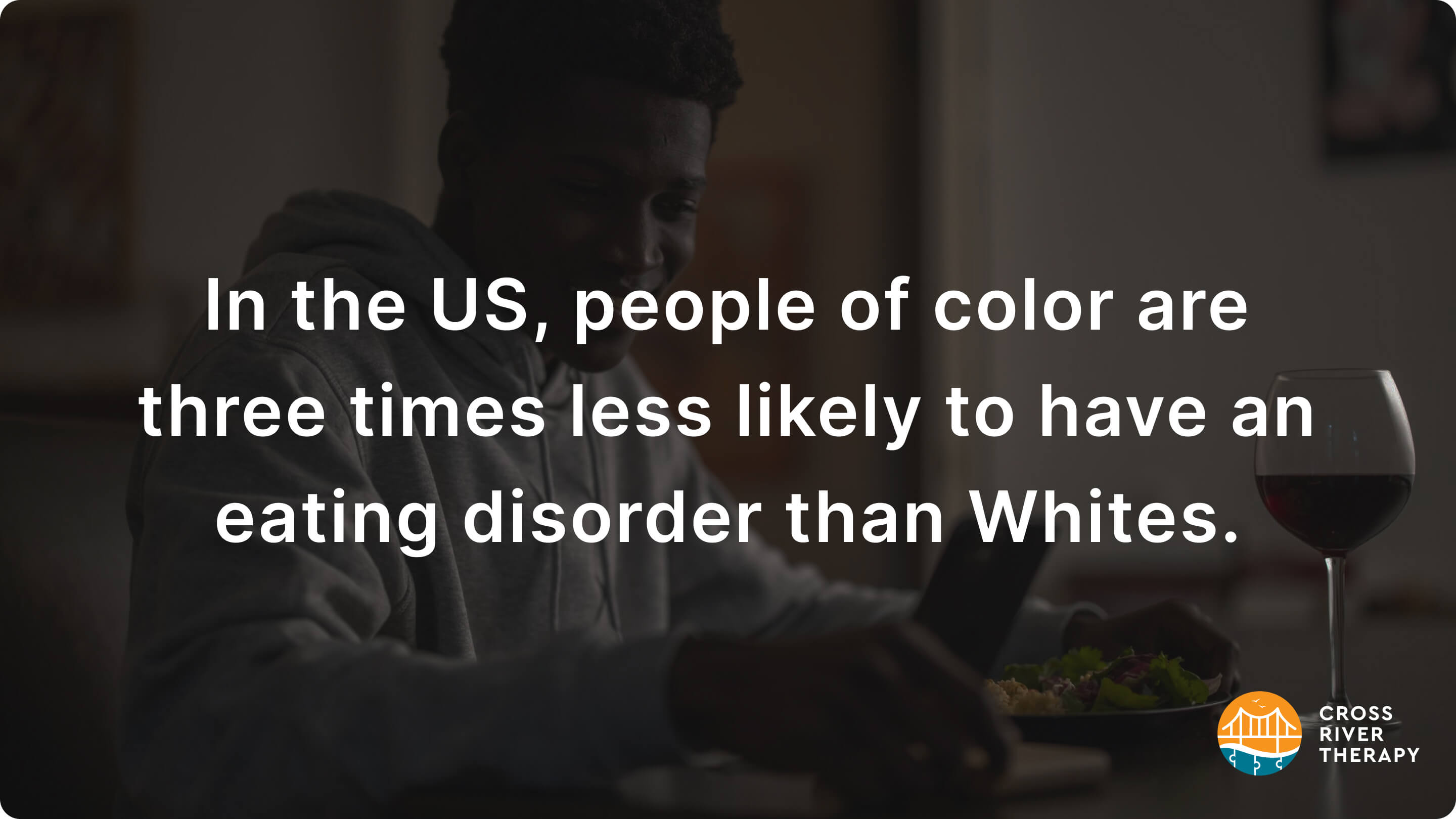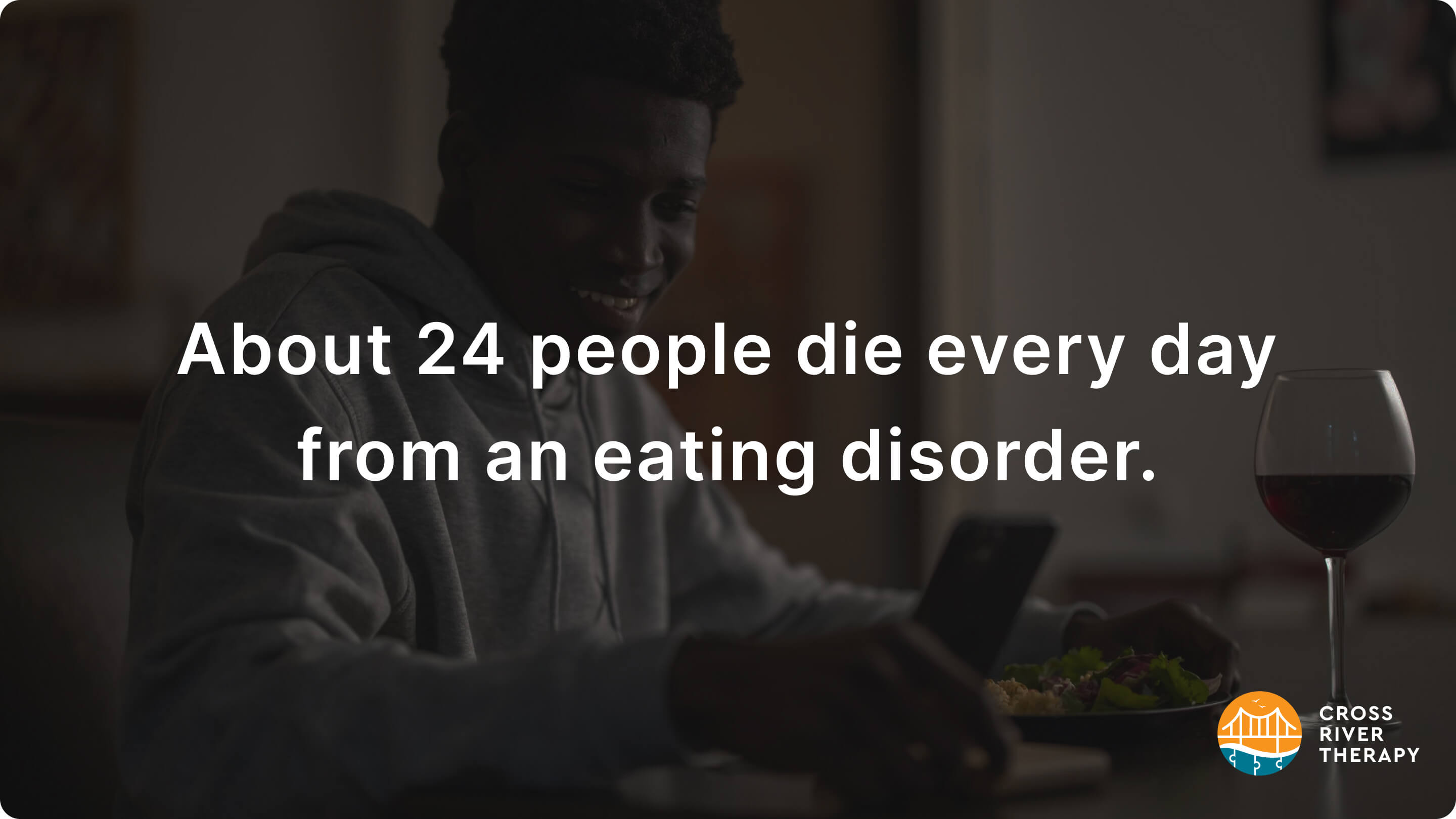43 Eating Disorder Statistics & Prevalence
9% of the US population (28.8 million Americans) suffers from eating disorders. Find more up-to-date eating disorder statistics and facts that’ll surprise you.

Key Eating Disorder Statistics
- Eating disorders affect at least 9% of the global population.
- 9% of the U.S. population suffers from eating disorders. The percentage accounts for 28.8 million Americans.
- 6% of people with eating disorders are diagnosed with the status of being underweight by healthcare professionals.
- Between 28% and 74% of people that are at risk for getting an eating disorder get it from heritability, or as a genetic trait from their family.
- Of all mental illnesses, eating disorders are one of the most fatal, with 10,200 deaths occurring every year. By the percentages, this is higher than the people that die from opiate overdoses.
- There's one death every 52 minutes from an eating disorder, comparatively high with other drugs-induced overdoses and fatalities. People from all genders, ethnicities, and age groups can be affected by eating disorders.
- 26% of people with eating disorders try to commit suicide at some point.
- The cost of eating disorders to the US population is $64.7 billion annually.
- Women that have physical debilitations are at higher risk of getting eating disorders. Things like an inability to walk, physical deformities, or injuries to the body can compound into an increased risk as well.
- Between 20% and 30% of adults that have eating disorders have been diagnosed with mild to severe autism spectrum disorder. Autism, when left undiagnosed, has been shown to lead to suffering from other debilitating factors, such as depression, anxiety, and anorexia.
- Between 3% and 10% of kids and teenagers with diagnosed eating disorders have ASD. People with autism have problems with sociability, talking with other people, and making friends. As tantrums are also an issue, they may prevent some children from regularly eating, particularly in severe cases.
- 20% of women are anorexic and experience symptoms that are commonplace with autism. However, research shows that some of them experience little advantages from treatment that's related to their eating disorders, Of course, this changes for everyone, though the missed diagnosis could be the reason for poor eating habits in such people.

How Common Are Eating Disorders?
11. According to researchers in the field of anorexia, about 30 million US residents are living with an eating disorder.

12. Among chronic debilitations, eating disorders rank as the third most common place for teenage women in America.
13. There are over 10 million men in America that will have an eating disorder within their lifetime, according to research in the field.
14. The prevalence of eating disorders over a lifetime is high for people with a binge eating disorder of some form, comprising 5.5% in comparison to bulimia at 2%. It's 1.2% for anorexia.
15. Under 6% of Americans with eating disorders have their diagnoses by a medical professional. With such a low percentage, it's difficult to obtain the professional help that they need.
16. People with a large body mass can be at risk for developing eating disorders after losing weight. This is also common among people with eating disorders that have bulimia, or binge eaters.
17. Large people are 50% more likely than others with ordinary or underweight bodies to get a diagnosis for an eating disorder.
By Age
17. Throughout the world, 13% of women that are older than 50 will experience eating problems in some form that requires treatment by a healthcare professional.

18. After evaluating a group of 496 adolescent girls for eight years until they reached the age of 20, medical researchers found that 5.2% of them met the standards for a diagnosis of binge eating, bulimia, and anorexia. They also listed symptoms that don't target specific disorders, though 13.2% had an eating disorder under that criteria.
19. The average age for the beginning stages of eating disorders is 21 years for people who binge eat, and 18 years for those with bulimia Nervosa.
20. Between 2001 and 2004, the lifetime prevalence of eating disorders in the United States was 2.7% for teenagers.
21. Of teenagers, one of the primary eating disorders, those 17 and 18 years of age have the most prevalence of all other teens, listed at 3%.
By Gender
22. The prevalence of eating disorders among young women is 3% globally, with men accounting for 1.5%. These stats were taken by researchers between 2001 and 2004.

23. 56% of transgender individuals that have eating disorders think that their disorder isn't relevant to their physical makeup.
24. Dissatisfaction with one's body is one potential factor that can lead to an eating disability.
25. Transgender individuals are 3 times more likely to have an eating disorder than women.
26. Fewer than 6% of people that have an eating disorder will receive a proper diagnosis from someone at a hospital or other medical facility.
27. Although genetics play a large role in whether someone will get an eating disorder, 26% of people won't inherit it from their family members.
By Race
28. In the US, African Americans, Indigenous groups, and other people of color are three times less likely to have an eating disorder or experience symptoms that are synonymous with eating disorders.

29. Black people with eating disorders are 50% less likely to get a proper diagnosis or to get any treatment at all.
30. African Americans have a lesser chance of being diagnosed with anorexia than white Americans do, though they could experience identical symptoms for a longer period.
31. Black adolescents have a 50% greater chance than white teens of showing bulimic symptoms of any kind. Things like binge eating and purging food are telltale symptoms of bulimia.
32. People of Hispanic ethnicity stand a 60% greater chance of having bulimia or experiencing bulimic symptoms than the non-Hispanic population.
33. College students of Asian American ethnicities have greater levels of anxiety about their bodies, having negative opinions about the fears of becoming overweight. The level of this dissatisfaction is greater than 50% in comparison to other nonwhite groups.
By Country
34. The prevalence of eating disorders around the world rose 3% from its 3.4% level from 2000 to 2018.
35. 70 million people are living with different eating disorders globally.

36. Of all the countries in Asia, Japan records the highest rates of eating disorders. Additionally, Singapore, Hong Kong, South Korea, and Taiwan have led Asians to high rates of eating disorders.
38. The highest prevalence rate for eating disorders in Europe occurs in Austria, having 1.55% in 2012.
39. About 50% of US residents know of at least one person with an eating disability.
Eating Disorder Mortality Rate: How Many People Die Of Eating Disorders?
40. About 24 people die every day from an eating disorder.

There is no other mental illness with a mortality rate higher than that of eating disorders, which sufferers being over 50 times more likely to attempt suicide.
41. Over 50% of people with eating disabilities abuse alcohol and other drugs at five times the rate of everyone else. If alcoholism is a concern, this can be especially worrisome since excessive amounts may cause more frequent vomiting, leading to rapid weight loss 97% of people that end up in the hospital for eating disorders have other conditions underlying them, such as severe depression, mood swings, and even psychiatric disorders.
Others associated with eating problems are post-traumatic stress disorder, substance abuse, obsessive-compulsive disorder, and anxiety disorders.
Binge Eating Disorder Statistics
In the United States, binge eating disorder is the most prevalent, with 3% of American adults having a binge eating disorder at some point in life.
US women will get binge eating disorders at some point. This makes the disorder more than three times as prevalent as bulimia and anorexia.
Only 43% of people with binge eating habits will get the treatment that they need.
Eating Disorder Treatment
With the right treatment, 60% of eating disorder patients will recover in full. Yet just one out of 10 people with the disorder will ever get treatment.
Anorexia Prevalence: How Many People Have It & Die From It?
5% of the US population currently has anorexia.
Of the people that have anorexia, 20% of people die from the disorder. For the few that do seek treatment, finding proper care can be another issue. One big problem with anorexia is that the majority of people that need help the most don't receive it.
For this reason, it can be difficult to make a concrete number on the number of people that have it, yet haven't been treated.
Some percentages don't account for people with no diagnosis.
A lack of diagnosis could lower the number of people that die every day from the illness. Depending on the location, treatment for anorexia can be vastly different.
Still, the chances of making a healthy recovery, regardless of the variation in treatment centers, are guaranteed to boost their likelihood of making a healthy recovery.
References
- https://www.nimh.nih.gov/health/topics/eating-disorders
- https://anad.org/eating-disorders-statistics/
- https://www.nationaleatingdisorders.org/statistics-research-eating-disorders
- https://www.hopkinsallchildrens.org/Services/Pediatric-and-Adolescent-Medicine/Adolescent-and-Young-Adult-Specialty-Clinic/Eating-Disorders/Eating-Disorder-Facts

Have Any Questions?
Whether you're curious about our services or need support, we're just a click away. Reach out or check our FAQs for quick answers.

